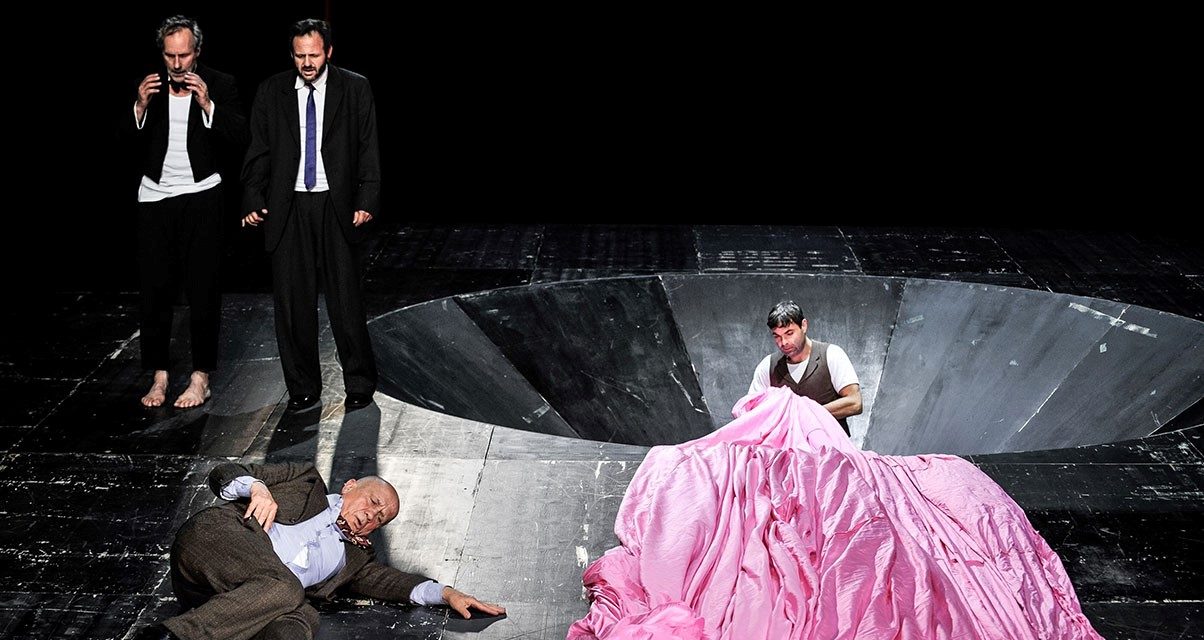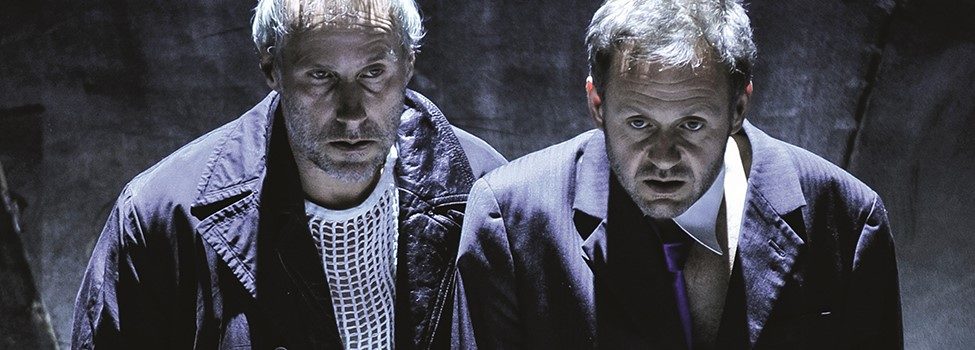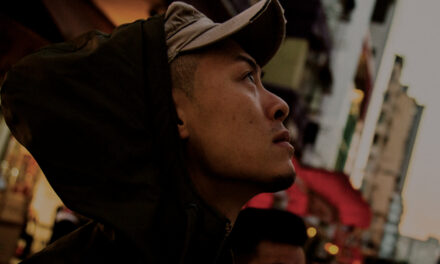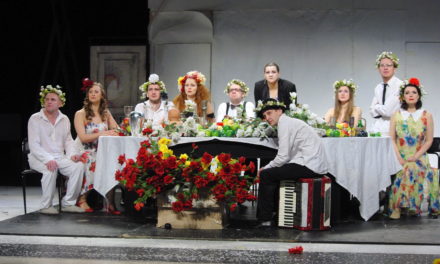The emblem of human existence
The stage has a rectangular ramp on it, covered with a large pink cloth, inclined at an angle of about 30 degrees in the black space of the stage and directly facing the audience. There is a small hole-like dent in the middle of the ramp. The performance begins with gradually intensifying lighting of the smooth surface, and a picture increasingly resembling a cosmic landscape comes into spectators’ view: an unreal bright-pink plane with perfectly straight lines, hurled somewhere out there in the unknown and infinite darkness of the universe. The pink cloth begins very slowly to crumple and is pulled into the dent in the middle of the ramp until it is completely swallowed and a deep hole opens up amid bare grey metallic terrain. Then the shapeless pink heap that has piled up in the hole begins to stir and slides down, unveiling two human beings: Estragon and Vladimir. They come out of the hole and start moving uncertainly around the stage and speaking haltingly while waiting for Godot.
This is how the remarkable staging of Waiting for Godot (Warten auf Godot), directed by Ivan Panteleev at Deutsches Theatre Berlin opens. The production was invited to be performed on 15–16 June at the National Theatre, Sofia, as part of the tenth edition of the World Theatre in Sofia festival, which has established itself as the most prestigious theatrical event held in Bulgaria’s capital city. Before being shown to Bulgarian audiences, the production had already been highly acclaimed as a major achievement of 2015 German theatrical life. Following its premiere on 28 September 2014, it was recognized as one of the 10 top productions of that season at the Theatertreffen Berlin 2015 festival of German-speaking theatre. Samuel Finzi and Wolfram Koch received the annual Gertrud-Eysoldt-Ring 2014 award for their parts as Vladimir and Estragon respectively, and Theater Heute magazine named Samuel Finzi Germany’s Top Actor for 2015.
There is hardly a better epitome of Beckett’s most celebrated play, brilliantly summarizing the existential human condition, than the above-described laconic visual solution by the stage and costume designer Mark Lammert. Lammert proposed this setting for the entire performance to the director Dimiter Gotscheff, who died in 2013, during preliminary work on his production of Waiting for Godot, and Gotscheff approved it immediately, the designer himself told drama historians, theatre critics, directors, actors, students and reporters at a meeting held at Goethe-Institut, Sofia, on 16 June after its first show in Bulgaria. A year later, Ivan Panteleev and the actors of the renowned director decided to bring the production to the stage as an affectionate homage, deeming Mark Lammert’s design to be the closest and the most relevant to their reading of Beckett’s play. This absurdist drama, and especially its emblematic title, Waiting for Godot, synthesises to the utmost the existentialist view of the human condition. Man is born and spends life waiting for death. In his short mortal life, Man is cast into an unknown, unknowable and threatening universe, where what he knows of himself and of his role in it more or less certainly, if anything, is that he has to die. Man, with Sisyphean indefatigability and tragicomic inventiveness, fills day after day of this waiting with insignificant chatter, minor actions and small plays, so as to put up with the absurdity of the efforts to live in a world devoid of stable reference points, waiting for one’s death. Mark Lammert condenses powerfully, with expressionist verve and the contemporary reflection of an early-twenty-first-century artist, the philosophical content of the piece into a formidable and unforgettable emblematic image: Man’s earth is a stranded, desolate island in the vast outer space, while his life is just a moment in a small empty space around a crater gaping towards the unknown and the non-being.
Living on the edge
To Ivan Panteleev and his team, the text of Waiting for Godot tells everything about Man and Man’s existence, and this is why it is always extremely soulful and contemporary, even now. This is why it not only needs not to be super-interpreted and surrounded by references to a particular social, political or other context but also why it would be too self-conceited and unnecessary to scrupulously highlight all its boundless associations. The director and the actors have instead enthusiastically given themselves to the moment of their own reading onstage of the great Beckett’s play (defined as “the twentieth-century Hamlet” by a number of researchers), of their present unique experience of roaming across its enigmatic and tragicomic universe. This turns each of the performances of the production into an immediate personal experience both to the four actors and to each of the spectators.
In his production, Ivan Panteleev skilfully employs two strategies of reading the dramaturgical text. He, on one hand, traces with philosophical enthusiasm and professional proficiency the main direct and metaphysical connections and figures in Beckett’s narration about Man and Man’s being. Man is a roamer and a clown in the desert of life, facing the necessity of enduring existence, burning with fear of and longing for death. Estragon and Vladimir are the two sides of human existence – the body and the mind – while the master, Pozzo, and the servant, Lucky, are the social transformation of this dualism. The couple Pozzo-Lucky is a compressed parodic image of each (social, psychological, etc.) system based on the power-obedience figure. In the long run, the only thing Man meets while spending life in waiting to leave it, is this (still going on and on now) problematic attempt at a human organisation, at a social system. The director, on the other hand, is strictly focused on the metaphor – strongly emanating from the text – for man’s existence as ‘living on the edge,’ as an incessant going round and leaping across the edge of the abyss, from which we have come, over which we would lean with curiosity or despair and where we’d return. Ivan Panteleev concentrates the action of the performance entirely on the visual image of this metaphor in the stage design solution by Mark Lammert. Samuel Finzi (Vladimir) and Wolfram Koch (Estragon) appear / come to life onstage / on the Earth, jumping over the edge of the round hole in the middle of the metal ramp, and afterwards everything they do or that happens to them takes place while they walk, stand or sit near that edge, unable to walk away from it, and in the moments when they want to ‘hear’ or ‘understand’ things better, they simply lie on it in weird positions or frantically run on the steep walls of the dent. Andreas Döhler (Lucky) and Christian Grashof (Pozzo) appear, are present, and disappear in the same manner.
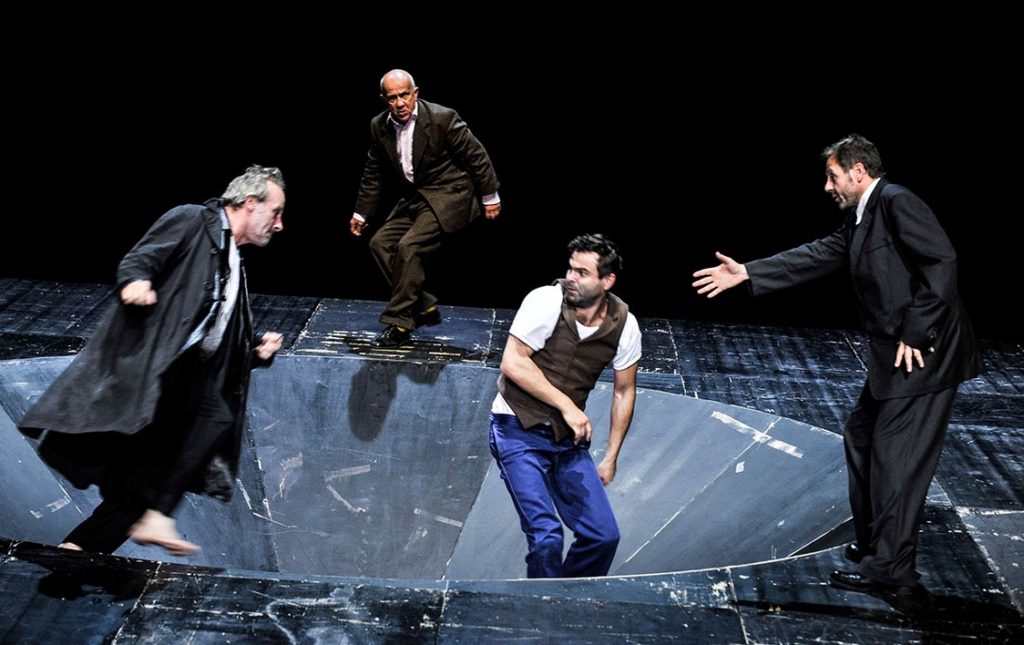
Wolfram Koch (Estragon), Andreas Döhler (Lucky), Samuel Finzi (Vladimir) and Christian Grashof (Pozzo). Photo credit Arno Declair
The unbearable (silken pink) heaviness of being
Traditionally, the stagings of Waiting for Godot have particular props, meticulously described in Beckett’s stage directions: a folding stool; a picnic basket carried by Lucky; a rope passed round Lucky’s neck for Pozzo to drive his slave; hats; Estragon’s boots. There are no props at all in Deutsches Theater’s production. Even the famous dead tree is replaced with a street-style lamppost. The stunning Samuel Finzi, Wolfram Koch, Andreas Döhler and Christian Grashof need not the described objects to express, play, show Beckett’s characters’ insecurity, fear, fatigue, pretended optimism and desperate inventiveness and indefatigability. Emblematic accents on their virtuosity are two scenes in the performance: Andreas Döhler as Lucky, who as a new Sisyphus rolls into a ball, endlessly raises and drops the large pink cloth (instead of the picnic basket and the stool), which in the beginning covers the metal ramp, and the unbelievable play with finger-snapping of Samuel Finzi as Vladimir and Wolfram Koch as Estragon instead of exchanging their hats in Act II.
An event of a production, the closer to the very strong tenth edition of World Theatre in Sofia.
Warten auf Godot (Waiting for Godot) by Samuel Beckett, directed by Ivan Panteleev; stage and costume design by Mark Lammert; lighting design by Robert Grauel; sound design by Martin Person; dramaturgy by Claus Caesar; German translation by Elmar Tophoven. Cast: Wolfram Koch, Samuel Finzi, Andreas Döhler, Christian Grashof
Ruhrfestspiele Recklinghausen / Deutsches Theater, Berlin, June 15–16, World Theatre in Sofia (at the stage of National Theatre) The visiting performance was supported by Goethe-Institut, Sofia, and Theatrical Spaces programme. World Theatre in Sofia is on the Calendar of Cultural Events 2016 of Sofia Municipality.
This post was written by the author in their personal capacity.The opinions expressed in this article are the author’s own and do not reflect the view of The Theatre Times, their staff or collaborators.
This post was written by Kamelia Nikolova.
The views expressed here belong to the author and do not necessarily reflect our views and opinions.

